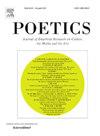The dual clustering of tastes and ties: Extending the notion of relational similarity in cultural fields
IF 2
2区 社会学
0 LITERATURE
引用次数: 0
Abstract
Sociological research on culture has long conceptualized categorical differentiation in terms of relational “distances” and relied on network imagery to describe the structural properties of fields of cultural production and consumption. Partly constrained by research design, extant research on relational similarity often focuses on either one-mode social networks, or two-mode cultural affiliation networks independently. Only a few recent empirical studies have considered the multiplex interaction between affiliations to cultural artifacts or categories and social relations embedding audience members within a system of dependence relations. We extend the notion of relational similarity to consider the interplay of cultural preferences and social ties and explore how distances between cultural genres are shaped by the mutually constitutive relation linking individual preferences and social networks. Analyzing a large online network of users (N = 43,549) and their expressed music preferences, we show that considering preferences alone results in two genre clusters separated by crisp boundaries. Considering both preferences as well as social network ties yields a sparse, connected component where the boundaries of genre categories become blurred. The study provides evidence that the structure of the space spanned by musical genres varies considerably once the connectivity properties of tastes and ties are jointly considered. This happens because social connections expose individuals to a set of potential future preferences that is typically broader than the set containing their current personal tastes. We discuss the qualitative implications of this result and its significance for future research on the duality of cultural tastes and social ties.
品味与关系的双重聚类:关系相似性概念在文化领域的扩展
社会学文化研究长期以来将范畴分化概念化为关系“距离”,并依赖网络意象来描述文化生产和消费领域的结构属性。在一定程度上受研究设计的限制,现有的关系相似性研究往往只关注一种模式的社会网络,或两种模式的文化联系网络。最近只有少数实证研究考虑了对文化制品或类别的隶属关系与将受众成员嵌入依赖关系系统中的社会关系之间的多重相互作用。我们将关系相似性的概念扩展到考虑文化偏好和社会联系的相互作用,并探索文化类型之间的距离是如何由连接个人偏好和社会网络的相互构成的关系形成的。通过分析一个大型在线用户网络(N = 43,549)和他们表达的音乐偏好,我们发现单独考虑偏好会导致两个类型集群被清晰的边界分开。考虑到玩家的偏好和社交网络联系,游戏类型的界限变得模糊。该研究提供的证据表明,一旦共同考虑到品味和联系的连接特性,音乐类型所跨越的空间结构就会发生很大的变化。这是因为社会关系将个人暴露在一组潜在的未来偏好中,这些偏好通常比包含他们当前个人品味的集合更广泛。我们讨论了这一结果的定性含义及其对未来研究文化品味和社会关系的二重性的意义。
本文章由计算机程序翻译,如有差异,请以英文原文为准。
求助全文
约1分钟内获得全文
求助全文
来源期刊

Poetics
Multiple-
CiteScore
4.00
自引率
16.00%
发文量
77
期刊介绍:
Poetics is an interdisciplinary journal of theoretical and empirical research on culture, the media and the arts. Particularly welcome are papers that make an original contribution to the major disciplines - sociology, psychology, media and communication studies, and economics - within which promising lines of research on culture, media and the arts have been developed.
 求助内容:
求助内容: 应助结果提醒方式:
应助结果提醒方式:


